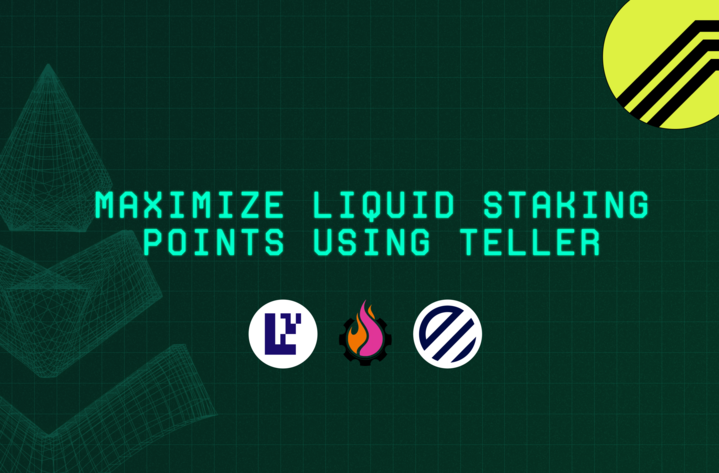How to Use Teller Time-Based Loans to Maximize Liquid Staking Points

Liquid staking tokens (LSTs) and the platforms that support them have become integral to the DeFi ecosystem. With over $53b in locked assets, LST platforms like EigenLayer, Pendle, Gearbox, and Renzo are rapidly evolving and solidifying their presence in the market.
Recently, AiRev significantly boosted their EigenLayer points by 4.8x and Renzo points by 9.5x using Teller and Gearbox. In the sections and step-by-step guides below, you'll find all the information you need to achieve similar results with Teller.
AiRev’s EigenLayer Points Farming Strategy
AiRev borrowed 100 WETH against their long-term $PRIME holdings as collateral using Teller. To achieve an exposure of approximately 1500 WETH to EigenLayer, they deployed the liquidity via Gearbox restaking strategies. The quick liquidity provided by Teller enabled AiRev to take advantage of an anticipated airdrop in the crypto space. Here is how they did it:
Step 1: Sourcing Liquidity with Teller
AiRev started by securing liquidity using their long-term holdings in $PRIME as collateral. They obtained a time-based loan through Teller, which provided the necessary funds to deploy into EigenLayer restaking strategies.
Step 2: Depositing into Renzo Protocol via Gearbox
Next, AiRev used the loan to deposit 100 WETH into Renzo Protocol through Gearbox. Renzo Protocol was chosen for its low cost-per-point strategy for earning EigenLayer points. This deposit significantly increased AiRev's EigenLayer points by 4.8x while also earning 9.5x points simultaneously on Renzo.
Step 3: Assessing the Risks
AiRev identified the primary risk in their strategy as the depeg risk of EZETH, rather than ETH price risk. For the strategy to fail, EZETH would need to depeg to approximately 0.8679 ETH. Given Renzo Protocol's strong on-chain liquidity position, AiRev deemed this scenario unlikely.

Maximizing Points Farming on EigenLayer
A Teller Cash Advance Strategy with Renzo and Gearbox
A Teller DeFi cash advance loan opens up numerous opportunities for farming strategies. Protocols sometimes have point systems where users can earn points linked to future airdrops by swapping, depositing, staking, or providing liquidity. If a wallet is low on liquidity, a Teller cash advance loan can provide the tokens needed to maximize participation.
Renzo is EigenLayer's Restaking Hub, designed to enhance the Ethereum staking experience through liquid restaking. This protocol serves as a bridge to the EigenLayer ecosystem, offering higher yields and more efficient staking strategies. Integration with various DeFi platforms such as Gearbox allows users to further leverage their restaked assets.
Gearbox is a DeFi protocol that enables composable leverage, allowing borrowers to deploy assets like $WETH into escrowed DeFi positions, thereby increasing exposure. Depositing WETH into Renzo Protocol via Gearbox can yield higher returns on more than one protocol simultaneously. Positions on Gearbox are managed within a Credit Account, a smart contract specifically designed to interact with other DeFi protocols.

How to Take Out a DeFi Cash Advance on Teller
Teller allows users to obtain short-term loans secured by their crypto holdings. These short term loans are best thought of as a DeFi cash advance as opposed to a traditional loan. Here’s how it works:
Step 1: Connect Your Wallet
Connect your cryptocurrency wallet to the Teller platform using supported wallets like MetaMask, Coinbase Wallet, or others that support Web3 connections.
Step 2: Review Tokens with Available Loan Offers
View the tokens in your wallet that are eligible for loan offers. The Teller platform will display the available loan opportunities based on the tokens you hold.
Step 3: Examine Loan Offers
Review the available loan offers for each eligible token. Offers vary based on:
- Loan-to-Value Ratio (LTV): The percentage of the token's value that can be borrowed.
- Annual Percentage Rate (APR): The interest rate applied to the loan.
- Duration: The length of time the loan is active.
Step 4: Select and Execute a Loan
Choose a preferred loan offer and initiate the loan process in a single transaction:
- The chosen collateral (tokens) is moved into an on-chain escrow smart contract.
- The loan capital is transferred directly to your wallet.
Step 5: Repayment
At the end of the loan duration, repay the loan along with any applicable fees to release your collateral from the escrow smart contract.

How to use Teller to accumulate points on Renzo
Step 1: Obtain a Loan with Teller
Use any token as collateral to secure a time-based loan in WETH through Teller. Rember, there are no margin-call liquidations for the duration of the loan.
Step 2: Connect a Wallet
Use an Ethereum-compatible wallet (such as MetaMask) and connect it to the Renzo Protocol interface.
Step 3: Stake Assets
Stake ETH or LSTs into Renzo Protocol, receiving ezETH in return.
Step 4: Deploy into Strategies
Use ezETH to participate in high-yield strategies across integrated DeFi protocols.
Step 5: Earn and Harvest Rewards
Monitor participation and harvest rewards periodically.

Increasing Points Farming on via Teller, Renzo, & Gearbox
Step 1: Obtain a Loan with Teller
Use any token as collateral to secure a time-based loan in WETH through Teller.
Step 2: Deploy Loan into Gearbox
Deposit the loan amount into Renzo Protocol via Gearbox.
Step 3: Maximize Yields with Leverage on Gearbox
Leverage the deposited assets to earn EigenLayer points and Renzo Protocol points.
What is an LST?
A liquid staking token (LST) is a type of token that represents staked assets in a blockchain network. Unlike traditional staking, where assets are locked and inaccessible for a certain period, LSTs allow users to maintain liquidity while earning staking rewards. This means users can continue to participate in DeFi activities, such as trading or lending, with their staked assets, providing greater flexibility and potential returns.
Where Does Teller Fit In?
Teller plays a crucial role by facilitating time-based loans, essentially functioning as a DeFi cash advance. This innovative approach allows users to maximize their liquidity and leverage their assets effectively.
What is Teller?
Teller is a DeFi platform that offers time-based loans using Ethereum assets as collateral. Teller provides a fixed, time-based loan structure, allowing borrowers to secure liquidity without selling their assets. In traditional DeFi lending, oracles are used to track asset values. If the price of an asset fluctuates too much, a user's loan can get liquidated. With Teller, there are no margin calls and no oracles. All loans are time-based, and the only risk of liquidation is failing to repay or extend the loan on time. A Teller loan is best thought of as a sort of cash advance rather than a traditional DeFi loan.
Loans can be over-collateralized, under-collateralized, or even non-collateralized, with custom terms set by lenders and borrowers. Lenders set the terms and duration of the loan. Borrowers accept these terms and agree to repay the loan within the specified timeframe. If the borrower defaults, their collateral is liquidated. Teller loans can only be liquidated if the borrower doesn’t repay within the agreed timeframe i.e. 3, 7, or 30 days. This means there are no price-based margin calls, offering borrowers a safer way to manage their assets.This is beneficial for borrowers who can repay but cannot monitor the market constantly.
Teller supports any asset on Ethereum Mainnet, Polygon, Base, Arbitrum, and. Some tokens used as collateral are $PRIME, $OD, and $TRADE.
TLDR;
Teller's time-based DeFi cash advance loans allow users to unlock liquidity. Without the risk of margin-call liquidations, users can maximize point farming strategies via any other protocol in the ecosystem. By utilizing Teller's cash advance and Gearbox's composable leverage, user’s can participate in protocol’s like EigenLayer for points farming.
Ready to unlock the potential of your crypto assets? Start borrowing with Teller today at teller.org.
Glossary
Points Farming: The process of earning points through various DeFi activities, often linked to future airdrops.
Airdrops: Distribution of tokens or cryptocurrencies to a large number of wallet addresses, typically as a marketing strategy or reward for community participation.
Long-term Hold Assets: Cryptocurrencies or tokens that users intend to keep for an extended period, rather than trading frequently.
DeFi (Decentralized Finance): A financial system built on blockchain technology that operates without central financial intermediaries.
Liquid Staking Token (LST): A type of token that represents staked assets in a blockchain network.
LTV (Loan-to-Value Ratio): The percentage of an asset's value that can be borrowed.
APR (Annual Percentage Rate): The interest rate applied to a loan over time.
On-chain Escrow Smart Contract: A smart contract that securely holds collateral on the blockchain until the loan is repaid.
Composability: The ability of different DeFi protocols to interact and integrate with one another.
Leverage: Using borrowed funds to increase the potential return on an investment.
Credit Account: A smart contract within Gearbox designed to manage assets and interact with other DeFi protocols.
Depeg Risk: The risk of a stablecoin or token losing its peg to a specific value, such as EZETH depegging from ETH.
